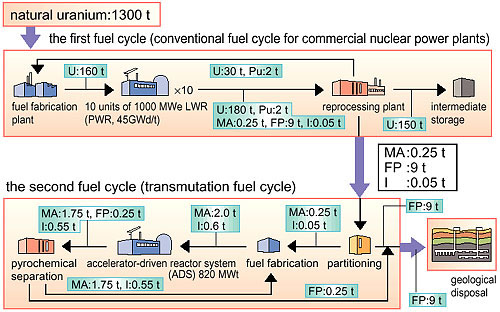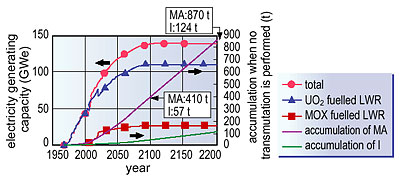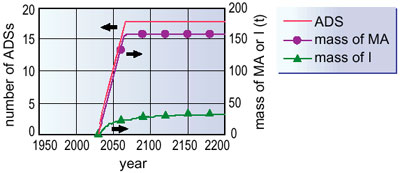A double strata fuel cycle consists of a transmutation fuel cycle, in addition to the conventional fuel cycle for commercial nuclear power plants (Fig. 5-4). The transmutation fuel cycle is very much smaller in scale than the conventional one, and incinerates long-lived radioactive materials, such as minor actinides (MA) and iodine (I-129), in high level wastes generated from the conventional fuel cycle. JAERI has proposed a concept of accelerator-driven reactor system (ADS) for incineration as one of the major devices in the transmutation fuel cycle. An ADS allows the incineration of 250 kg MA and 50 kg I-129 annually. These amounts which are produced annually by about 10 units of 1000 MWe LWR with uranium fuel. The other technologies, such as partitioning, pyrochemical separation and fuel fabrication, are now under engineering tests.
To investigate the effectiveness of the transmutation fuel cycle on the reduction of the accumulation of long-lived radioactive materials, a scenario of long-term nuclear power generation in Japan is assumed, where whole nuclear power is produced by LWRs
of which 80% use UO2 fuel and 20% MOX
fuel. According to the scenario, when transmutation is not performed, the accumulation of MA and I-129 reaches 870 and 120 tons respectively in the year 2200, and continues to increase thereafter (Fig. 5-5). On the other hand, when transmutation is performed, accumulation of MA and I-129 is kept nearly constant 160 and 30 tons, respectively, from around the year 2060 and in addition, much of the accumulated MA and
I-129 is kept contained within the transmutation fuel cycle (Fig. 5-6). The transmutation fuel cycle can reduce long-lived radioactive materials to be ultimately disposed of in the underground by about one-hundredth.
JAERI has been actively carrying out R&D aiming at realizing the double strata fuel cycle which allows to largely reduce the accumulation of long-lived radioactive materials and then to mitigate the problems associated with ultimate geological disposal of high level wastes. |



